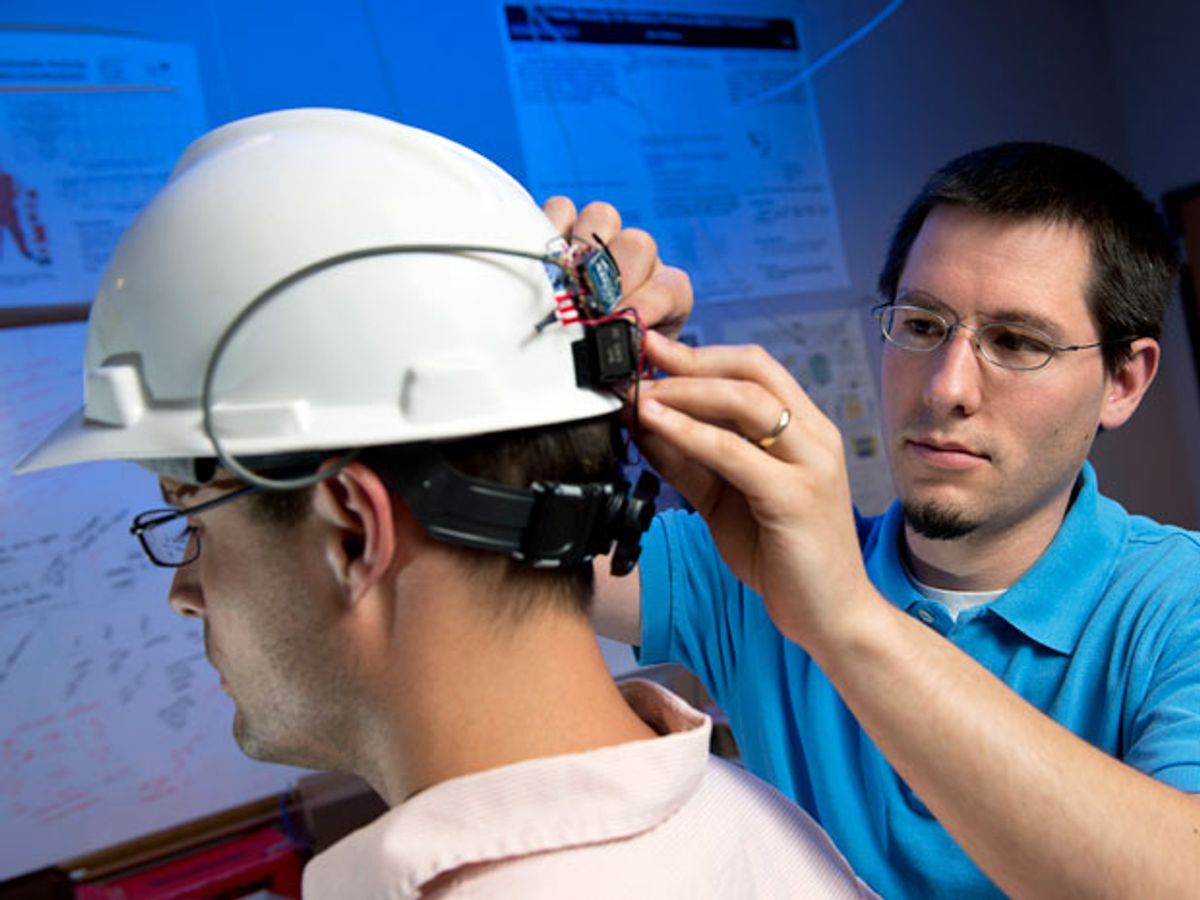During the 1990s, nearly 100 American workers died from suffocation injuries; twenty percent of these succumbed to carbon monoxide poisoning, usually from operating gasoline-powered tools in confined spaces. CO suffocates its victims by tying up oxygen-transporting sites in hemoglobin, preventing oxygen from reaching the body. CO poisoning is insidious, quickly producing nausea, fatigue, headache, and disorientation, followed by unconsciousness and, too often, death.
One or two deaths a year is not a big number—unless you are one of the one or two, or a member of their families. Extending the electronic measurement of our lives into the workplace, researchers at Virginia Tech combined wearable computing and prevention-through-design to develop a practical sensing and alarm system that can tell when a worker’s blood oxygen level is cratering and prevent carbon monoxide poisoning.
The result was a standard construction hard-hat modified to include a non-invasive blood-oxygen monitor. This week, the authors—Jason B. Forsyth, Thomas L. Martin, Deborah Young-Corbett, and Ed Dorsa—received the IEEE Transactions in Automation Science and Engineering’s Best Paper Award for their efforts.
The design combines a pulse oximeter (the Nonin Xpod), a small radio transmitter (the Digi Xbee), a nine-volt battery and a 3.3-volt regulator, all tucked into a package that adds very little weight to a standard hard-hat. The LED/sensor package keeps watch through a small window cut in the front of the helmet’s headband. The headband turns out to be one of the trickiest parts of the design: It has to keep the sensors in position over a consistent spot on the wearer’s forehead, without being so loose that the sensor shifts with the user’s every movement, or so tight that it interferes with blood flow in the skin.
The pulse, in this case, refers to the cardiovascular pulse rather than an electromagnetic pulse. The pulse oximeter uses two LEDs—one emitting red light at 660 nm and another shining infrared at 910 nm—with a photodiode that measures the radiation reflecting back from the skull beneath the skin. The amount of blood in the capillaries and vessels beneath the skin varies during the circulatory pulse, as does the oxygen saturation (and hence the color) of the blood. Bright red, highly oxygenated blood (HbO2) absorbs more infrared light. Dark red, deoxygenated blood absorbs more red light.
The algorithm tracks the relationship between variations in the intensities (I)of the red and infrared reflections to create a very close index of the fluctuations in the total blood oxygen saturation. Since I can’t resist, the index, R, is
R = ln (Ired minimum / Ired maximum) / ln (Iinfrared minimum / Iinfrared maximum)
Other studies, most of them military, have investigated field applications of pulse oximeters. The Virginia Tech (VT) study, though, advances the field in two ways. Most important, it approaches the sensor as a “repairable system.” That is, it recognizes that field conditions (including ambient light seeping in under the headband) and the wearer’s movements (from nodding or shaking the head in conversation to sweeping, bending, and hammering) will inevitably interfere with measurement. The VT group developed protocols for recognizing and working with the swaths of bad information, while still assuring that there is a greater than 99% probability of warning the user of impending carbon monoxide poisoning while there is still time to get out and get help. And in line with its real-world emphasis, the study focuses on designing sensor placement to maximize signal uptime (by reducing extraneous motion), user comfort, and practical wearability. At the same time, they note, some applications—such as running a jack-hammer—will likely never be compatible with this sort of through-the-skin monitoring.
This is an opening sally in a program to develop “wearable and ubiquitous” work-safety sensors that will help prevent not only asphyxiation deaths, but also injuries due to falls, electrocution, particulate inhalation, and pedestrian/heavy equipment accidents.
Douglas McCormick is a freelance science writer and recovering entrepreneur. He has been chief editor of Nature Biotechnology, Pharmaceutical Technology, and Biotechniques.



